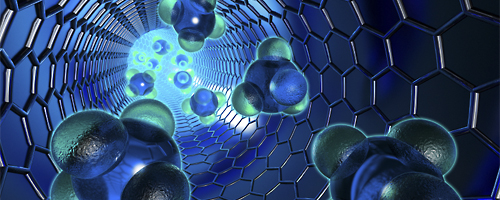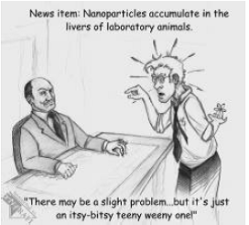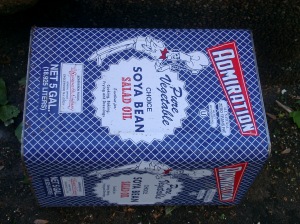What the heck is a nanoparticle? Surprisingly, they’ve been in our food supply and products we use everyday for decades; much like GMO’s. Nano-Technology, like GMO’s, is a totally unregulated field of science. The technology is for the building of small machines. Now that really sounds scary! Nano particles are used in the producing, processing, and packaging of our foods. Teeny, tiny bits of foreign matter used in packaging material to detect microbes; in dietary supplements, and in foods and drinks as food additives. They are used to “prevent caking, deliver nutrients and prevent bacterial growth.” But are they something we should be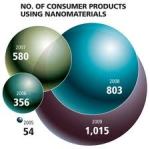 digesting?
digesting?
OK– so, Nanoparticles are all around us. I’m asking, are they harmful?
The answer is: they say they really don’t know. 😦
Nanoparticles are ultra fine materials that vary between 1 to 100 in size. A 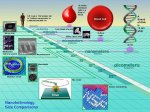 nanometer is a unit that measures length. It is one billionth of a meter.
nanometer is a unit that measures length. It is one billionth of a meter.
It’s a million times smaller than a millimeter. Nanoparticles, which range from 1-100 nanometers in size, are roughly the same size as biomolecules such as proteins, antibodies, and membrane receptors. http://www.sciencedaily.com/releases/2013/11/131107094021.htm
“There are 150-600 nano food and 400-500 nano food packaging application on store shelves.” They are added with no warning and no safety testing. Sounds a lot like GMO’s, huh?
A new study reveals that nanoparticles are being used in everything from beer to baby drinks despite a lack of safety information. 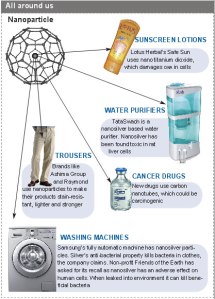
‘The U.S. Food and Drug Administration (FDA) currently does not specifically require nanoparticles to be proved safe but does require manufacturers to provide tests showing that the food goods employing them”—be it beer or baby products—are not harmful. “Industry would bear the burden of demonstrating the safety of the material under its intended conditions of use,” says FDA spokesperson Christopher Kelly. “Nanoparticle versions of [FDA-approved] materials may well be new materials” that would trigger new investigations, “and this is considered on a case-by-case basis.” http://www.scientificamerican.com/.
Funny, this self policing by the manufacturers didn’t work at all with genetically engineered foods. I’m curious to know, what makes them think its going to work with this???
Previous research has shown that nanoparticles can be absorbed by the skin, inhaled, or ingested; cross into the brain, or blood and even taken up by cells. While they say they aren’t harmful, let’s investigate a bit.
Titanium dioxide, “one of the top chemicals produced, worldwide,” is used in everything from paint to food and cosmetics. Its a mineral pigment, opaque, used in sunscreen, and in color cosmetics. It is thought to be carcinogenic, and they can penetrate your cells and cause DNA damage when exposed to sunlight. You actually put this in Sunscreen? DUH? There is also some fear that this may lead to skin cancer. Oh yea, this nano titanium is known to kill beneficial bacteria and soil microbes.
A study by Churg et. al. at the University of British Columbia in their paper “Induction of Fibrogenic Mediators by Fine and Ultrafine Titanium Dioxide in Rat Tracheal Explants” (1999) found that ultrafine particles of the anatase form of titanium dioxide, which are less than 0.1 microns, are pathogenic or disease-causing.
| Table 1: Measurements of Mineral Pigment Particles | |
| Particle Size | Measurement |
| Coarse | Less than 10 microns |
| Fine | Less than 2.5 microns |
| Ultrafine (nanoparticles) | Less than 0.1 microns or 100 nanometres |
| etcgroup.org | |
| Table 2: Particle Size and Entry into the Human Body | |
| Nanoparticle Size | Entry Point |
| 70 nanometres | Alveolar surface of lung |
| 50 nanometres | Cells |
| 30 nanometres | Central Nervous System |
| Less than 20 nanometres | No data yet |
| etcgroup.org | |
Danger to the cell depends on the size of the particle. What is interesting about this study is that the smaller the particle, the more toxic it became.
Nano facts from the Norwegian Institute of Public Health.
- Nanotechnology is technology on the atomic and molecular scale
- A nanometre (nm) is one billionth of a metre
- A nanoparticle is a particle with one or more external dimensions in the size range 1 nm — 100 nm
- The aspect ratio between a nanoparticle and a football is similar to that between a football and Earth
- Nanotechnology is working on a scale of 100 nm (which corresponds approximately to the size of a virus) down to the size of atoms, about 0.1 nm
“Toddler Health is a nutritional supplement containing nano iron particles that claims to offer toddlers increased bio-availability. Canola Active cooking oil contains NutraLease, a nutraceutical technology that uses nano-capsules to enhance the delivery of nutrients. A preservative known as AquaNova contains nano capsules of water insoluble substances to increase absorption in the body. McDonald’s burger packages contain nano-spheres that require less water and less time and energy to dry. Miller Beer bottles are made from Imperm, a plastic imbued with clay nanoparticles that are as hard as glass but stronger and provide longer shelf life. – See more at: http://www.non-gmoreport.com/articles/sept09/nanotechnology_parallels_
All this sounds alarming to me. When I think of all the damage that is being done from the introduction of GMO’s into our food supply; the idea of nanoparticles being added, “untested” is reason to fear. I’m appalled. Nanotechnology has made the nano foods industry a $6 billion market. And people are the guinea pigs, AGAIN, testing it. totally unaware.
I’m no scientist, but I am a researcher, I can read. And I can see from the information that is available out there that this is headed for disaster. There’s enough sickness and disease already, and they seem content in continuing to make it that way.
Major food companies, such as General Mills, Kraft, Nestle, PepsiCo, Cadbury-Schweppes, and Unilever are making the nano food and nano packaging a mainstream application. Monsanto isn’t involved in this, BUT, Syngenta, Cargill, Dupont, BASF, are all involved in some type of research or application of this technology. And they are affiliated with Monsanto, that’s enough for me to be concerned.
Some of the initial studies reveal some cancer causing potential. Nano silver, used as a coating in tableware, has been found to be “toxic to the liver, brain, and stem cells and may harm beneficial bacteria.” 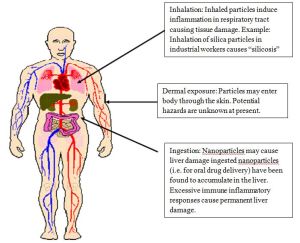
This stuff is “potent and toxic, even in small quantities.” And it also needs to be labeled like GMO’s, so at least we know, its our right…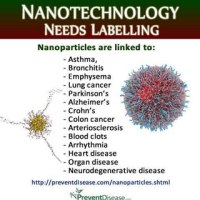
Here is a partial list of items known to contain nanoparticles of zinc oxide, 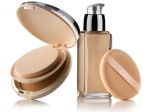 titanium dioxide, and/or silver: Sunscreens, Cosmetics, Dietary Supplements, Food and Beverage
titanium dioxide, and/or silver: Sunscreens, Cosmetics, Dietary Supplements, Food and Beverage 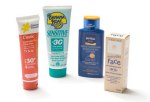 items, Appliances, Computers, Clothing. This post would go on too long if I tried to name all of the products that are using nanoparticles.
items, Appliances, Computers, Clothing. This post would go on too long if I tried to name all of the products that are using nanoparticles. 
The list goes on and on. Go to http://www.nanotechproject.org/cpi/products/ for a list of 1791 products that contain nanoparticles. This list includes food and non food items. You can browse by category. Plan to be amazed! I’d say if the word “nano” appears anywhere on a product it should be a NO-NO to you.
As always, I share because I care about you and the issues that affect us all. Let me hear from you…Oh, would you do me a favor and like my page. Thanks…
Additional sources:
The Project on Emerging Nanotechnologies. www.nanotechproject.org.
Associated Press. “Scientists concerned about nanotech products.” November 13, 2008.
Food and Water Watch. “The Risks of Nanotechnology.” September 2008
Ball, Philip, “Nanoparticles in Sun Creams Can Stress Brain Cells.” Nature. June 21, 2006.
KABC-TV. “Studies Show Nanoparticles Used in Sunscreens and Makeup can Harm the Environment.” March 26, 2009
“Down on the Farm: The Impact of Nano-scale Technologies on Food and Agriculture.” ETC Group. November 2004. –
